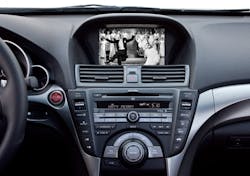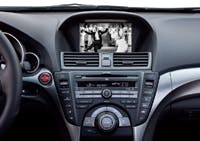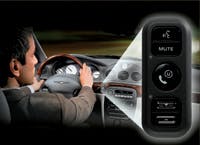For several years, car owners have been bringing an array of aftermarket and consumer devices — from navigation systems to portable DVD players — into their cars. Initially the pace of technology seemed to catch automakers by surprise. But that is changing — and changing fast. Increasingly, automakers are offering their own standard or optional equipment that provides enhanced functionality not available from aftermarket offerings.
Among these offerings are USB hookups for MP3 players that let the driver change songs through controls on the steering wheel, Bluetooth wireless links to enable drivers to control their cell phones via voice command and rear-seat entertainment systems with viewing screens built into the backs of the vehicle's front seats. Some industry stakeholders use the term "infotainment" to describe these offerings — and they're a bright spot for automakers. According to Toyota spokeswoman Allison Takahashi, about half of Lexus ES 250 buyers opt for audio systems ranging in price from $300 for wireless connectivity via Bluetooth technology to $4,250 for a voice-activated hands-free system that also includes navigation with voice recognition.The popularity of infotainment systems is not restricted to luxury models, says Richard Robinson, principal analyst for iSuppli Corp., a research firm that specializes in electronics markets. "Within a year or two, all models will have it as an option," he says.
In 2008, about 11 percent of new vehicles worldwide were equipped with Bluetooth capability, according to iSuppli, which predicts that percentage will climb to 50 percent by 2015. iSuppli says that about 5.7 percent of vehicles have a USB port, a number that will climb to about 53 percent by 2015.Considering the normal development cycle for new car models, it's not surprising that it took a few years to see new cars factory-equipped with these kinds of features. "In the automotive space, everything is signed off on four years into the future," notes Mark Fitzgerald, senior analyst for automotive electronics service for research firm Strategy Analytics. "But the design and life cycle of consumer electronics devices is much shorter."
Several automakers already offer strong infotainment options. Ford, for example, offers a range of infotainment options under the Sync brand on 14 Ford, four Lincoln and four Mercury models. Owners opting for the Sync platform can connect their cellphone, enabling them to answer a call by touching a single button and to place calls using voice commands. Sync's audio capabilities let drivers select music from their MP3 player or other audio device using voice commands. It also supports streaming audio via a phone or media player. Some 2010 Ford models offer voice-activated turn-by-turn directions and personalized traffic reports, news, sports and weather over the car's audio system.
Chrysler now offers an audio jack for an MP3 player on every vehicle model. An optional Uconnect system, available on several models, provides voice-activated directions and lets drivers play a song from an iPod, using the car's radio or steering wheel controls. Uconnect Phone provides voice control of a user's cellphone through a Bluetooth link. And on certain models, Chrysler offers rear-seat entertainment with Backseat TV from Sirius, which streams family-friendly content such as Nickelodeon and Disney Channel over a satellite link.
Factory-installed infotainment systems typically offer car buyers a higher level of integration with the vehicle than aftermarket solutions offer. Fitzgerald notes that some factory-installed navigation systems can work even in a tunnel. In that situation or whenever the vehicle cannot rely on its satellite link to a global positioning system, some factory-installed navigation systems can determine the vehicle's geographic coordinates using the dead reckoning method. "You can use the accelerometer or wheel speed sensors in the car to determine the position," explains Fitzgerald.
Factory-installed systems also may have an edge when it comes to aesthetics. "If you buy a real expensive car, you want a clean-looking dashboard," Fitzgerald notes.
The risk of theft also is likely to be lower with a built-in system than with an aftermarket solution — and the warranty may be stronger. "The warranty on Lexus factory components is 48 months/50,000 miles and tends to be better than for aftermarket components," notes Takahashi.
Although factory-installed infotainment systems may have a higher price tag than aftermarket offerings, car buyers may perceive that they are actually more affordable. "Ford's Sync system is in the high three-hundred dollars and you can roll it into the financing of the car for five years," comments Fitzgerald.
A $3,700 price tag hasn't stopped some buyers of Acura's new TL from purchasing an infotainment technology package that includes a hard drive that can store up to 2,500 songs and display real-time traffic and weather on a VGA screen. VGA is "like going from regular television to high-definition," says Jessica Fini, a Honda spokeswoman for the Acura brand. The VGA screen also works with a factory-installed camera to help the driver back up. Fini says that capability soon will be expanded to offer two additional views, top-down and wide angle views.
iSuppli expects the after-market share of the business to decline. How strongly automakers will fare is not certain.
With owners keeping their cars longer than ever, it's important for automakers to do their best to help ensure that systems installed today do not quickly become obsolete — and that's a key challenge considering underlying technologies such as Bluetooth are constantly evolving to support new features. Some car makers address this concern by offering car owners the ability to download upgrades onto a USB drive and bring it to their car. But some car owners may not have the patience to do that, which could create a business opportunity for service technicians to help owners keep their infotainment systems up to date.
An even bigger challenge for automakers could be charting the right course for infotainment development efforts for future model years. Fitzgerald notes the right course will depend, in part, on the capabilities built into products such as cellular phones. "In the future, the phone will have a broadband connection and quite a bit of memory," he says. The big question is how much media will go through the car.
Making the right judgment about these questions will determine in large part the future success of automakers in the infotainment business.




